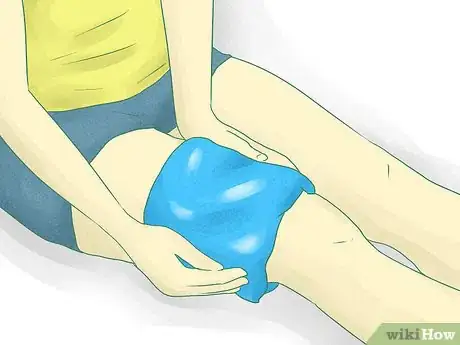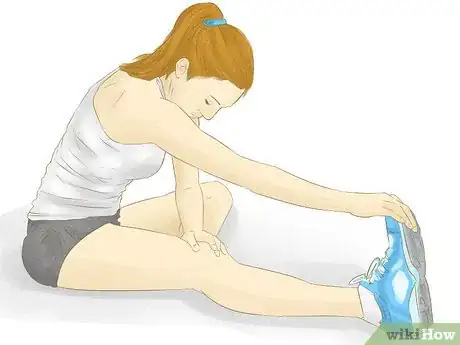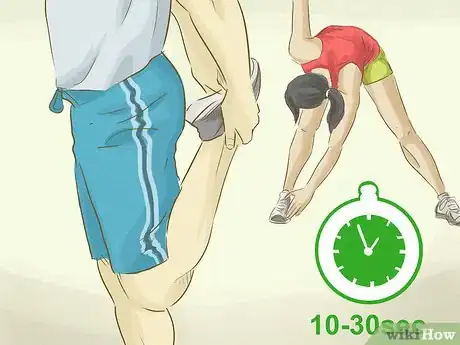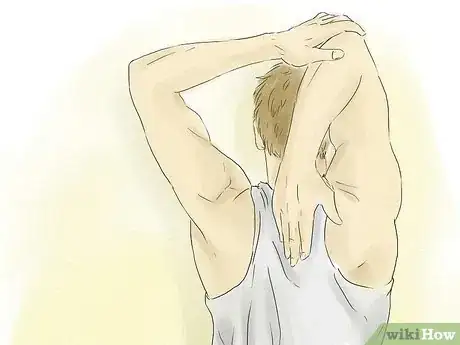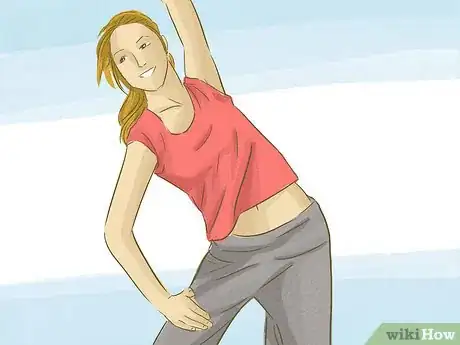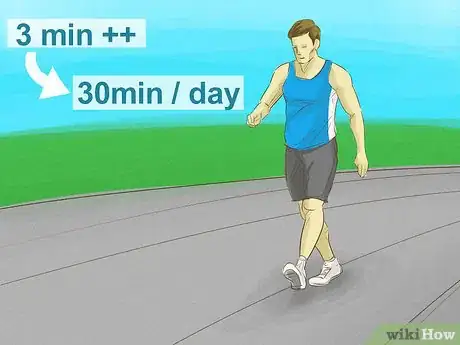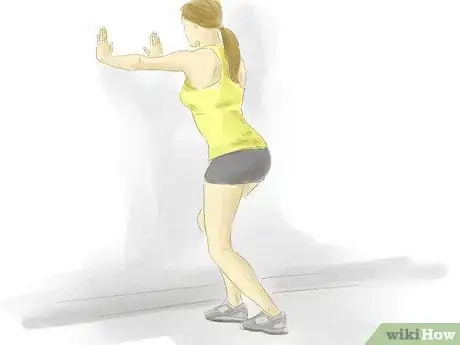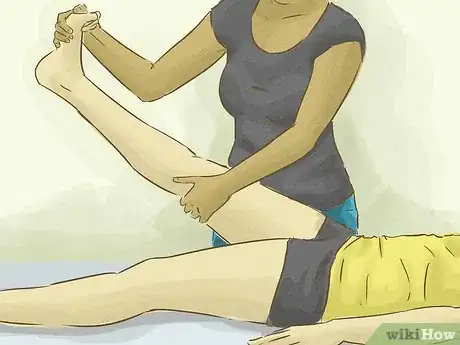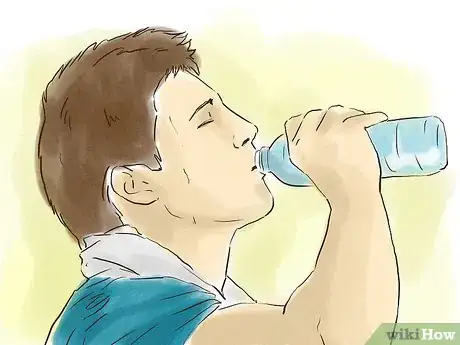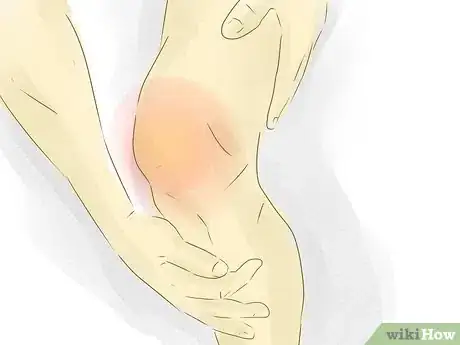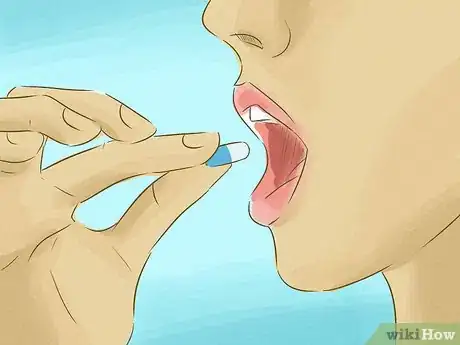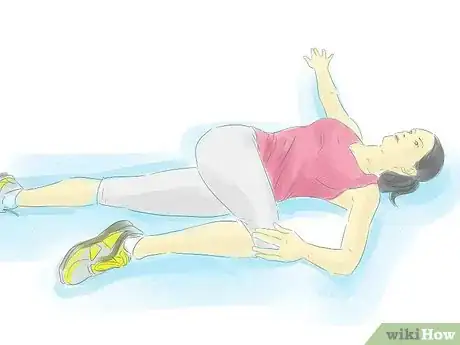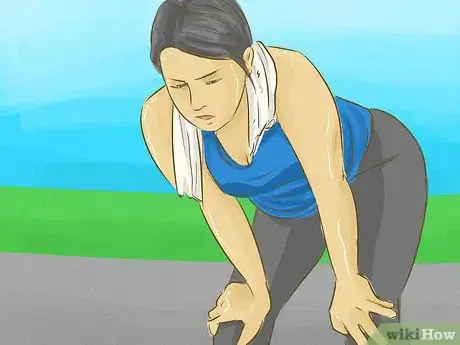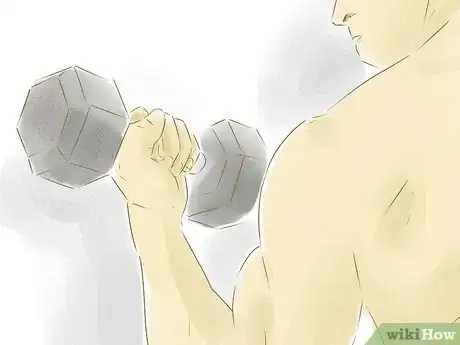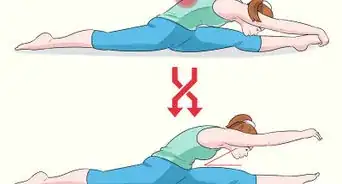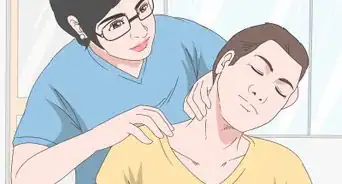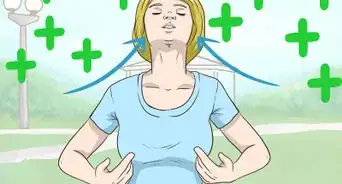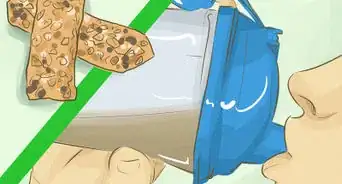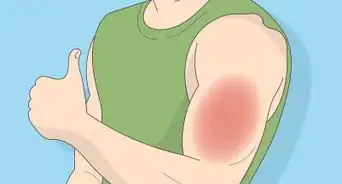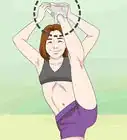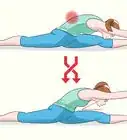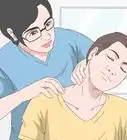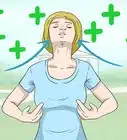This article was co-authored by Francisco Gomez. Francisco Gomez is the Head Coach at the FIT Potato Gym, a training gym established in 2001 in the San Francisco Bay Area. Francisco is a former competitive runner who helps endurance athletes train for major marathons like the Boston Marathon. Francisco specializes in Injury Rehab, Flexibility, Marathon Training, and Senior Fitness. He has a B.S. in Nutrition and Exercise Physiology & Running.
There are 10 references cited in this article, which can be found at the bottom of the page.
This article has been viewed 209,872 times.
Sore muscles can be quite painful and hinder your daily life and activities. While stretching cannot relieve muscle pain, it may help you feel better temporarily. You can try these at home, the office, or other places without having to resort to fancy massages or expensive drug remedies.
Steps
Stretching Sore Arm and Leg Muscles
-
1Warm up with dynamic stretches for 5 minutes. Dynamic stretches move your joints through their full range of motion. These activities can help lubricate your joints and make your static stretches safer. Try arm and leg circles, squats, and knee to chest stretches.
-
2Use static stretches that focus specifically on the sore muscles. Static stretches are where you lengthen a muscle and hold the stretch for 20-60 seconds (10-15 for children). You should always start a workout with dynamic stretching and finish with static stretching.
- Always hold static stretches for 20-60 seconds. Alternatively, time your stretches to last at least 3 or more deep breaths, making sure that you exhale slowly.
- When your muscles are stiff, you need to work on stretching them out. Be careful not to overdo it, but make sure you pay special attention to the muscles that are giving you discomfort.
Advertisement -
3Stretch your calf muscles. If your calves are sore, try some calf stretches. Sore calf muscles can be very uncomfortable. You have to use your calves a lot for walking, so it’s more difficult to give your calves the break they need when they are sore.[1]
- A standing stretch is a great way to stretch your calf muscles. Step 1 leg behind you, digging your heel into the ground. Lean forward to stretch the muscles.
- Another way to do this is to step forward instead of backwards, with your toes propped up and pressing against a wall. Lean forward to stretch the muscles.
- Hold the stretch for 20-60 seconds.
-
4Stretch your thigh muscles. These muscles are very important ones that you use all the time in your everyday movement. These stretches can help relieve tightness in the front of your thigh.[2]
- Stand up straight and tall. Push the hip on the side you are stretching forward. Take your right leg and use your hand to hold your foot at your butt.
- Hold this for 20-60 seconds and repeat with your left leg.
-
5Stretch tight hamstrings. The hamstrings are muscles between your hips and knees. To stretch these muscles, stand with your feet together and bend over at the waist. Focus on rolling your spine forward as you reach toward the floor. Let your head and arms hang while your leg muscles stretch.[3]
- If you have soreness in your back, try lying with your back flat on the ground. Grasp the ends of a towel, and place one foot in the towel with the knee slightly bent. Pull the towel towards your torso to stretch your leg. Hold it 20-60 seconds.
-
6Stretch your sore shoulder muscles. Sore shoulder muscles need extra love and care to speed up the recovery process. Attempt to stretch out your shoulder muscles to help reduce the discomfort of soreness[4]
- One good stretch is to cup one elbow with the opposite hand. Then lift your elbow and pull it across your chest, making sure to keep your body stationary. Hold this pose for thirty seconds and then release. Repeat these steps on the other arm.
- Another good stretch is the goalpost stretch. Grasp a resistance band, belt, or jump rope between 2 hands. Inhale and stretch your arms straight up above your head. As you exhale, bend your bends while spreading your arms apart like goalposts. Lower the belt and your shoulder blades. Repeat as you inhale.
-
7Try a standing side bend. This move can be really beneficial if your upper body and lower back are sore. It will temporarily ease the stiffness in your body.
- Stand with your feet together and hold your arms above your head with your palms together.
- Keep your arms straight while you lean to the left and then to the right, taking your time to stretch out the muscles on each side.
Stretching Other Sore Muscles
-
1Take it easy for a few days. When your muscles are sore, it means they are adapting to the new activity/movement and becoming stronger. However, for them to get stronger, you need to give them time to recover from the additional strain.[5]
- Cut back on the exercise for a few days when your muscles are sore. Or try some lower impact exercise activities like walking or swimming while you recuperate.
-
2Stretch sore ab muscles. Having strong core muscle strength is essential to overall health. It can also help you breathe better by stretching your diaphragm and intercostals. Try lying with your back flat on the ground. Keep your spine in a neutral position as your raise your arms straight up above your body. Hold for 20-60 seconds.
-
3Stretch your sore glutes. Sore glute muscles can be a pain since you use them so much in your everyday life. They are key to most of your motion, especially if you are an active person or a runner.[6]
- Try the pigeon pose. Sit down on a yoga mat on the ground. Bring one knee forward to the edge of the mat and stretch the other leg behind you. Align the foot of the bent leg with your knee so that they are perpendicular to the leg stretched behind you. Lean forward if you’re able to.[7]
-
4Stretch for general muscle soreness. There are other ways to relieve muscle soreness that involve objects or other people. Two of the most common stretches are foam rolling and assisted stretches.
- Foam rolling – This process is sometimes called “self-myofascial release.” Basically, it means that you use a foam roller or a lacrosse ball to apply pressure to specific points on your body to massage out the muscle soreness.[8]
- Assisted stretches – These stretches involve another person (hopefully a certified professional) who guides you through a stretching routine based on your specific flexibility needs. Sometimes they will use the pressure of their own body to help you safely achieve a deeper stretch.
Using Other Methods to Help Muscle Soreness
-
1Drink more water. Muscles recover from soreness more quickly when you are properly hydrated. Drink plenty of water when you are feeling muscle soreness to help speed up your recovery time.[9]
- An adult man should be drinking about 3 liters of water every day and an adult woman should be drinking about 2.2 liters of water every day.[10] So, you’ll need to drink more than that (at least one liter more per day) to help counteract the soreness in your muscles.
- Avoid things like alcohol and caffeinated soda that will work to dehydrate you even more.
-
2Put an ice pack on your sore muscle. Put a few ice cubes in a ziplock bag or cloth and hold it against where you hurt. Do this for 10-15 minutes. A cool bath or shower also helps.[11]
-
3Use heat on your sore muscles. After using the ice, (not immediately, wait about three hours) put hot water in a hot water bottle and place it on your sore muscles. Leave it there for fifteen minutes.
-
4Try legal non-prescription pain relievers. Use Advil, Ibuprofen, or Tylenol. Try to use these as a last resort. Always be sure to follow the instructions on the bottle and do not abuse the drugs.[12]
Preventing Muscle Soreness
-
1Warm up with dynamic stretching before a workout. Static stretching, where you hold a stretch in 1 position for several seconds, can lead to injuries and more soreness if done before a workout. To prevent injury, make sure you do dynamic stretching, where you move your muscles and joints instead of holding them.[13]
- Lunges, high kicks, and jump squats are all great ways to warm up before exercise.
- Walking, cycling, and jogging are also great warm-ups that get your joints moving.
-
2Perform static stretches after a workout. Once you have finished exercising, you can try static stretches like calf and shoulder stretches. This may help improve flexibility once your session is over.
-
3Take it slow if you are a beginner. Muscle soreness initially develops from pushing your muscles beyond their current capability. If you are just starting a workout regimen or a more active lifestyle, it is important to start out slowly and progress gradually. Doing too much too fast might do more damage than good.
-
4Don’t increase the volume of your workout too quickly. Muscle soreness can develop from adding too much too fast to your workout regimen. A good rule of thumb is to not increase the volume of your workout by more than 10% from one workout to the next. This will help your muscles adjust slowly over time instead of being overwhelmed all at once.[14]
What Are The Best Ways To Relax Tight Muscles?
Expert Q&A
Did you know you can get expert answers for this article?
Unlock expert answers by supporting wikiHow
-
QuestionWhy does my muscle hurt when I stretch?
 Francisco GomezFrancisco Gomez is the Head Coach at the FIT Potato Gym, a training gym established in 2001 in the San Francisco Bay Area. Francisco is a former competitive runner who helps endurance athletes train for major marathons like the Boston Marathon. Francisco specializes in Injury Rehab, Flexibility, Marathon Training, and Senior Fitness. He has a B.S. in Nutrition and Exercise Physiology & Running.
Francisco GomezFrancisco Gomez is the Head Coach at the FIT Potato Gym, a training gym established in 2001 in the San Francisco Bay Area. Francisco is a former competitive runner who helps endurance athletes train for major marathons like the Boston Marathon. Francisco specializes in Injury Rehab, Flexibility, Marathon Training, and Senior Fitness. He has a B.S. in Nutrition and Exercise Physiology & Running.
Fitness Coach
-
QuestionIs stretching better than yoga for improving flexibility?
 Francisco GomezFrancisco Gomez is the Head Coach at the FIT Potato Gym, a training gym established in 2001 in the San Francisco Bay Area. Francisco is a former competitive runner who helps endurance athletes train for major marathons like the Boston Marathon. Francisco specializes in Injury Rehab, Flexibility, Marathon Training, and Senior Fitness. He has a B.S. in Nutrition and Exercise Physiology & Running.
Francisco GomezFrancisco Gomez is the Head Coach at the FIT Potato Gym, a training gym established in 2001 in the San Francisco Bay Area. Francisco is a former competitive runner who helps endurance athletes train for major marathons like the Boston Marathon. Francisco specializes in Injury Rehab, Flexibility, Marathon Training, and Senior Fitness. He has a B.S. in Nutrition and Exercise Physiology & Running.
Fitness Coach
-
QuestionWhat's the best way to stretch my quads and calves?
 Francisco GomezFrancisco Gomez is the Head Coach at the FIT Potato Gym, a training gym established in 2001 in the San Francisco Bay Area. Francisco is a former competitive runner who helps endurance athletes train for major marathons like the Boston Marathon. Francisco specializes in Injury Rehab, Flexibility, Marathon Training, and Senior Fitness. He has a B.S. in Nutrition and Exercise Physiology & Running.
Francisco GomezFrancisco Gomez is the Head Coach at the FIT Potato Gym, a training gym established in 2001 in the San Francisco Bay Area. Francisco is a former competitive runner who helps endurance athletes train for major marathons like the Boston Marathon. Francisco specializes in Injury Rehab, Flexibility, Marathon Training, and Senior Fitness. He has a B.S. in Nutrition and Exercise Physiology & Running.
Fitness Coach
Warnings
- Don't bounce or do any dynamic or ballistic motions while stretching sore muscles.⧼thumbs_response⧽
- Make sure you don't get any boiling hot water on you. Always put it in a hot water bottle. There shouldn't be any direct skin contact.⧼thumbs_response⧽
References
- ↑ Francisco Gomez. Competitive Runner. Expert Interview. 24 October 2019.
- ↑ Francisco Gomez. Competitive Runner. Expert Interview. 24 October 2019.
- ↑ Francisco Gomez. Competitive Runner. Expert Interview. 24 October 2019.
- ↑ https://www.prevention.com/fitness/7-exercises-that-instantly-un-hunch-your-shoulders/slide/1
- ↑ http://www.webmd.com/fitness-exercise/sore-muscles-dont-stop-exercising?page=2
- ↑ Francisco Gomez. Competitive Runner. Expert Interview. 24 October 2019.
- ↑ http://www.athletico.com/2012/06/12/glutes-and-piriformis/
- ↑ http://breakingmuscle.com/mobility-recovery/what-is-a-foam-roller-how-do-i-use-it-and-why-does-it-hurt
- ↑ Francisco Gomez. Competitive Runner. Expert Interview. 24 October 2019.
- ↑ http://www.mayoclinic.org/healthy-lifestyle/nutrition-and-healthy-eating/in-depth/water/art-20044256
- ↑ http://www.mensfitness.com/training/pro-tips/tips-for-relieving-muscle-soreness
- ↑ http://www.mensfitness.com/training/pro-tips/tips-for-relieving-muscle-soreness
- ↑ http://greatist.com/fitness/12-biggest-myths-about-stretching
- ↑ http://www.builtlean.com/2012/07/11/muscle-soreness/
About This Article
To stretch to relieve sore muscles, first start by doing dynamic stretches, like arm and leg circles, for 5 minutes so you can warm up your joints and make it safer for your body to move into static stretches. Then, if your calf muscles are sore, try stretching them by putting one leg behind you, digging that heel into the ground, and leaning forward. If you have sore thigh muscles, stand on one leg and hold the other leg by your foot behind you so that it’s by your butt. When stretching, hold each position for 20 to 60 seconds at a time. Remember to listen to your muscles so you don't overdo the stretching. For more help from our co-author, including how to stretch your sore glutes with a move called the pigeon pose, scroll down!
